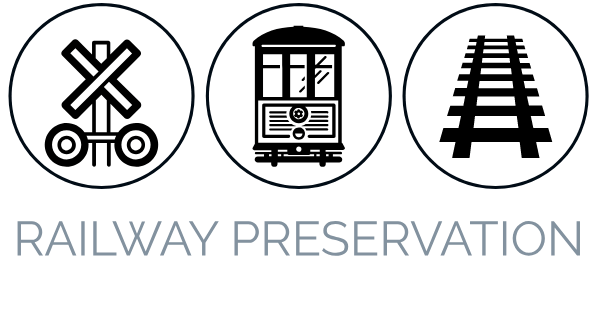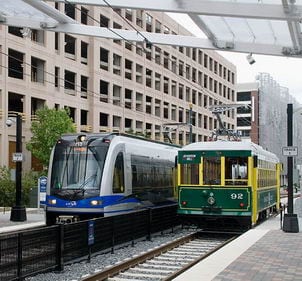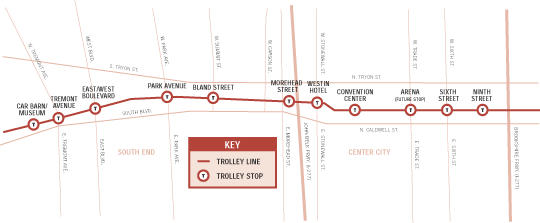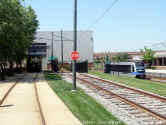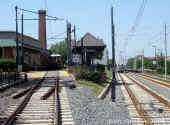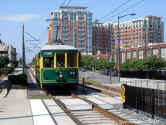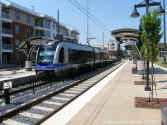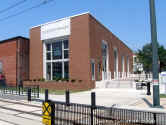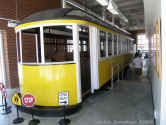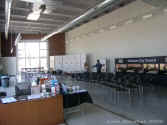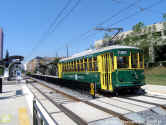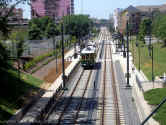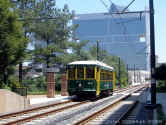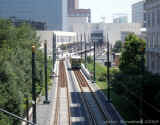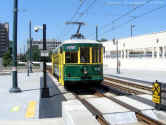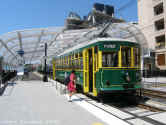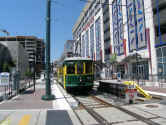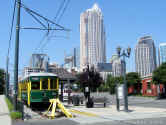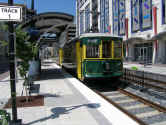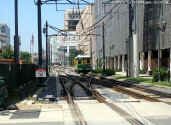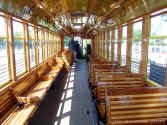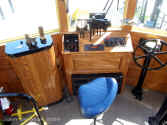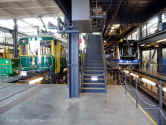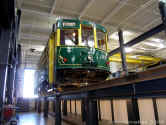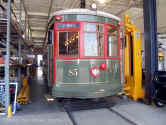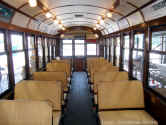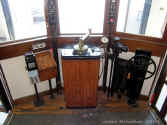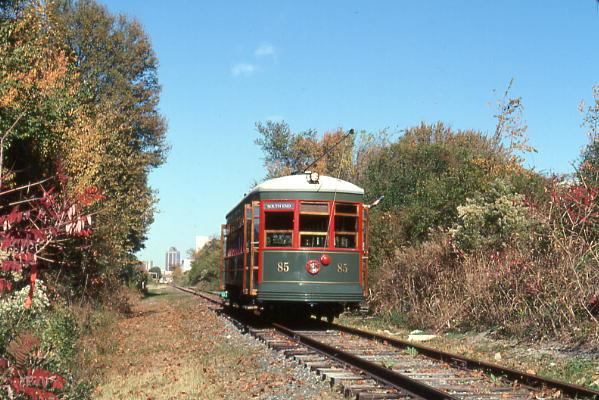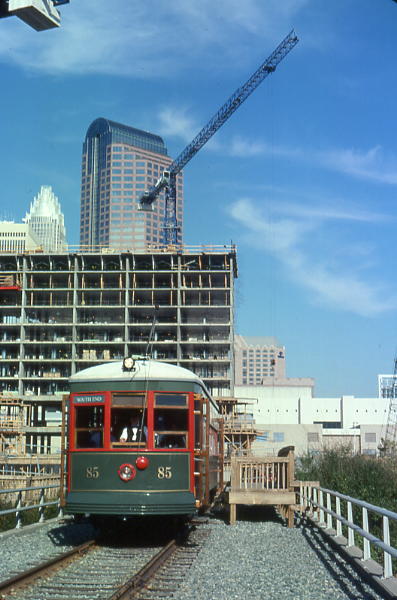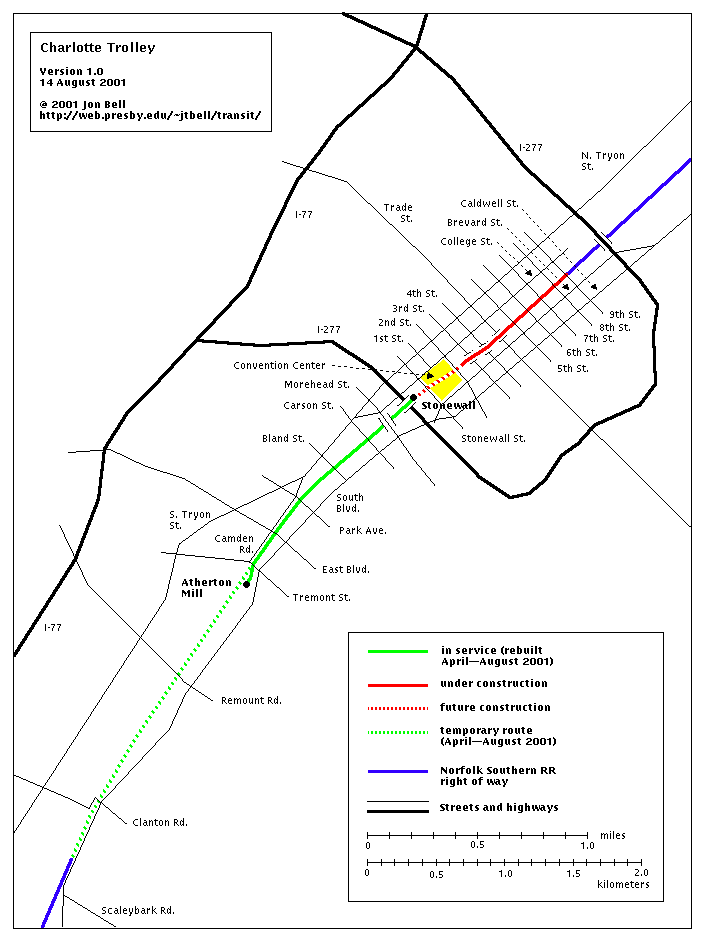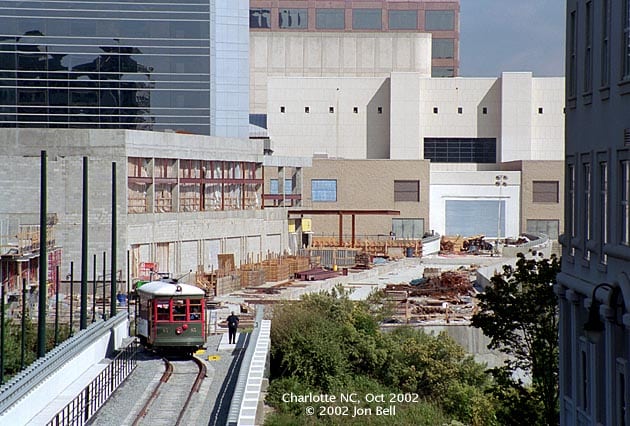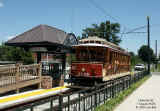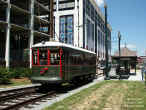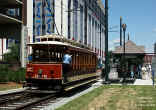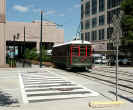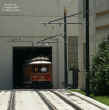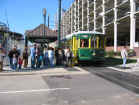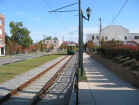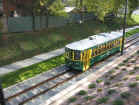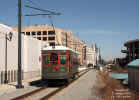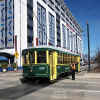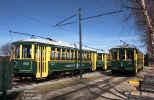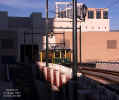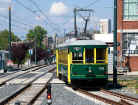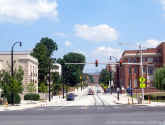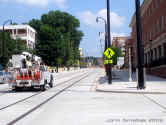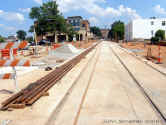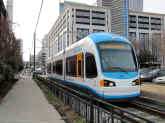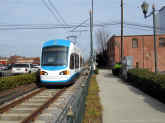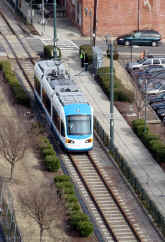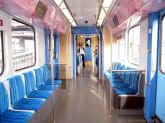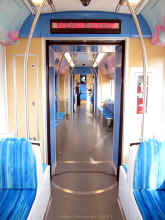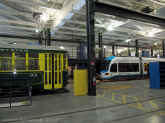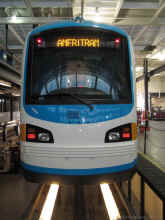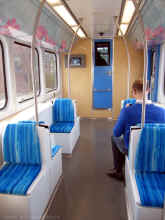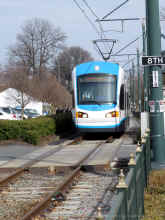U.S. Streetcar Systems- North Carolina
Charlotte
Charlotte Trolley Inc.
Began Operation: 1996
Route Miles: 2.1
Stops: 11
Org: Transit Agency + Non-profit
Schedule: Service Replaced with Light Rail
photo: Jon Bell
Charlotte Trolley is a classic case of a grass-roots non-profit effort which started small and blossomed into something big. Operations began on an abandoned rail spur in 1996. The group used a restored Charlotte streetcar towing a diesel generator to provide electric power. The line connected Charlotte’s South End district with downtown Charlotte, using a city-owned railroad right-of-way. From these modest beginnings, the line was incrementally upgraded into a modern transportation corridor that today is part of the City’s new light rail system.
By 2003, the initial operation had been upgraded with new track, overhead, stations and replica Vintage Trolley vehicles. That same year, the non-profit Charlotte Trolley turned over the operating reigns to the Charlotte Area Transit System (CATS). Charlotte Trolley continued its participation as an important “friends of the trolley” support organization. The $40 million investment by the City of Charlotte and CATS had created a two-mile transit corridor that formed the basis for constructing the new light rail system then in the planning stages. The trolley operation and the anticipation of the new light rail service spurred an intense level of economic development along the corridor. More than $400 million in new projects, apartments and condominiums, shops, restaurants and more were added along the route during this initial period.
Starting in June 2004, trolley operations started on a daily basis using restored original Car 85. The car had been updated with different trucks and a modern control system. In July, an additional replica car from the Gomaco Trolley Company joined car 85. In October 2004 three new Gomaco replica trolleys arrived and began operating the bulk of the service. In February 2006, the line was shut down to allow construction of the City’s first light rail line, which would overlap the existing trolley corridor at its north end.
Operation of the Lynx light rail line began in November of 2007. Vintage trolley service resumed in April 2008, operating over the northern end of the line between Atherton Mill and 9th Street. The trolley shares station stops with the light rail service, but utilizes terminals which are physically separated from the line. As of Summer 2009, one car operates weekends only. The trolley offers hourly departures from each end of the line, immediately following a light rail departure to avoid impacting regular operations. Trolleys also run during the week for charters and other special operations.
Equipment: Until the purchase of three Gomaco replica trolleys, the mainstay of Charlotte Trolley service was Duke Power car 85. Something of a local celebrity, car 85 was built in the Charlotte streetcar shops in 1927, and in 1938 it received the honor of being the last streetcar to operate in Charlotte. Following retirement it saw several secondary uses, finally becoming part of a house in Huntersville, NC. It was acquired by the Historic Landmarks Commission in 1986 and restored locally over a multi year period. The three Gomaco replica trolleys arrived in 2004.
More details of the fascinating saga that is Charlotte Trolley can be read in the Updates section below.
News & Updates (Scroll Down for Latest Updates)
4/3/01- Crowder Construction of Charlotte is the apparent low bidder for the contract to rebuild the entire 1.96 mile line and install overhead wire. The line will be graded for double track, but will initially receive only single track with passing sidings. The contract will also include reconstruction of the Stonewall St. bridge, which is where the current trolley operation ends. As yet unresolved is the method of bringing the line through the Charlotte Convention Center, which will be worked out later and included in a separate contract. The intention is for all construction to be compatible with light rail standards. Work started on April 2, and is scheduled for completion before the end of 2002. Sources: Rail Transit On Line, Charlotte Trolley.
5/22/01- During track reconstruction, service has been annulled over the line between South Blvd. and Stonewall St. Instead, the trolley is temporarily running south to Scaleybark, a distance of approximately 1.5 miles. Track work on the original line is expected to be completed as far as Park Ave. on July 1, and to Stonewall St. on August 1. Source: Charlotte Trolley. JS Photo.
11/01 Construction Update- construction on the 1.96 mile trolley corridor is progressing rapidly. The pictures below were taken by John Smatlak during the week of November 5, 2001. The corridor is really starting to take shape! Particularly impressive is all of the development taking place along the line. The trolley continues to operate with its towed generator, with overhead trolley wire expected to be finished by the August 2002.
12/01 Convention Center trackage presents additional challenges- When construction of the new trolley corridor was approved, the final design for routing the line through the Charlotte Convention Center was deferred. With the new right-of-way now in place on either side of this gap, the issue has assumed center stage with the emergence of several costly, and time-consuming proposals for completion. The local business community has expressed its strong support for the trolley line in several recent op-ed pieces in local media outlets.
In the photo, car 85 is at the current end of the line. The Convention Center is the low-rise white building in the right background. Bridge piers are already in place to carry the elevated track to the spot where the track is planned to pass through the structure.
2/7/02- The February 2002 edition of Rail Transit Online had this update on the Convention Center issues-
City officials have suddenly done an about face and now say they can get the heritage trolley extension from the South End to the Uptown area running by next February. The original plan called for the line, which is now under construction, to open in August of this year. The tracks would be shared with the proposed $331-million South Corridor LRT line that won’t be completed until February 2006. But the route cuts through the main hall of the Charlotte Convention Center, where engineers decided to build an elaborate, glass-enclosed and sealed tunnel complete with an underpass so that people using the facility would not have to walk across the tracks. However, the trolley could have begun operation without the tunnel because the streetcars would be smaller, lighter and run less frequently than LRVs. But convention center officials did not want to tear up the building twice and also felt they had a better chance of getting federal funding if the whole job was done at once. So it was decided to hold off trolley service until light rail could be completed, a decision that angered business owners who were looking forward to the new customers the streetcars would bring. The new plan calls for construction to take place in the center’s public areas only once. That would happen this year and will include track laying and other changes needed for light rail. In 2005, the rest of the work would take place in a service area away from public view. The underpass, complete with elevators and escalators, would be installed as part of a planned expansion of the convention center. The city council will vote on the plan Feb. 25. Meanwhile, a revised proposal for building the tunnel is also scheduled to be ready this month, one that should cost far less than the $32 million previously estimated. A draft EIS on the 15-station, 10.3 mile LRT project should be ready in March.
6/1/02- Construction Update: Poles for the overhead wire are now being installed. It is expected that the overhead wire work will be completed by the Fall, and that the trolleys will begin operating via the trolley wire (instead of their tow-behind generators) by the end of the year. Also, the City of Charlotte has agreed to move ahead with the Convention Center track work; they expect to to award the contract in June, with work starting in July. This will permit Charlotte trolley to operate over the entire 1.96 trolley corridor, without having to wait for the completion of the full 10.3 mile light rail line in 2006. Source- Charlotte Trolley
This map from Jon Bell’s transportation web site provides a good look at the current trolley corridor. Mr. Bell’s site also has a series of excellent construction photos. Map credit: Jon Bell
6/10/02- Construction Photos: Thanks to Bill Blomgren of Charlotte Trolley for sending in these recent photos of the overhead wire system being installed.
6/17/02- Construction Photos: Jon Bell’s website has been updated to include a number of recent construction views, divided into two groups; South End and Uptown. A few are found below, check out his website for more.
11/21/02- Construction Photos: Jon Bell’s website has once again been updated with some recent construction photos. The photos detail the progress on spanning the gap in the line with a link through the Charlotte Convention Center.
3/14/03- Charlotte Trolley in Transition- As the $20.3 million trolley infrastructure project approaches completion, the non-profit Charlotte Trolley Inc. finds itself in a transitional period that marks the beginning of a new era for the group.
As of this date, the installation of the overhead trolley wire and two substations is essentially complete on the two mile line, with testing expected to begin in the near future. The construction of the elaborate suspension system that will support the track as it passes through the Charlotte Convention Center has been completed, although the track has not yet been laid on this short section. One other gap still exists in the line, adjacent to the Westin Hotel construction site. Track should be laid here as soon as the construction on the adjacent hotel site wraps up. Car 85 continues to run three days a week, towing its generator behind. To date, grade crossing protection continues to be provided by an onboard policeman. As for the group’s other cars, the Greek single-truck car is receiving testing and running gear work, the single-truck Birney is in the midst of a major overhaul, including work on its underframe, and the group continues to work on development and implementation of a plan to convert the double-ended PCC-type suburban car from its present Pennsylvania broad gauge to standard gauge running gear.
As Charlotte Trolley Inc. (CTI) and Charlotte Area Transit System (CATS) prepare to launch daily trolley service, a number of implementation issues are now receiving new attention. To begin, the suitability of CTI’s current group of cars to perform daily service has been questioned, and the need to finalize plans for a permanent storage and maintenance facility is also being scrutinized. CATS’ consultants have studied the issues at hand and issued a report, and CATS is currently weighing the options. The announcement that CTI’s historic cars were perhaps not the best option for daily service apparently came as quite a surprise to the local business community, which has invested an estimated $400 million along the trolley corridor over the past three years. CATS initial recommendation to reduce the level of trolley service to weekends and lunchtime only during the week proved to be quite controversial. Since then, other options are being looked at, including the possibility of refurbishing two of CTI’s cars, and acquiring two or more new replica cars. This option has been suggested in an article in the Charlotte Business Journal entitled “Getting Charlotte’s Trolley Back on Track”. Penned by Lynn Wheeler, an at-large member of the Charlotte City Council. The article is recommended reading and provides a good look at the current situation. (Ed. note: a March 13th article in the Charlotte Observer reports that CATS is talking to Little Rock, Arkansas about leasing two of their new Gomaco replica trolleys. The trolleys are done but the line is not ready yet)
With the significant investment and intense level of interest in the trolley corridor, it seems a solution will shortly be worked out. Certainly the project has come an incredibly long way from its roots as a single car being operated with a generator over disused freight railway tracks. We look forward to reporting on further developments. Sources: CTI Staff, Charlotte Business Journal
7/10/03- I have posted links to two news articles from June detailing the ongoing work by CATS to get Charlotte Trolley up and running. On a related note, consideration is being given to leasing two of the Gomaco replica cars built for Little Rock, Arkansas. Little Rock is not able to accept delivery of the two cars at this time and so a lease may prove workable.
11/3/03 Updates- Local Transit Agency Will Run Vintage Trolley Service- An early 2004 date now looks probable for the start of daily service on the new trolley corridor. The final phases of construction, and the source of considerable delays, have been the track running over the Westin Hotel’s parking deck, and the trackage through the Convention Center.
With the start of daily service, Charlotte Area Transit System (CATS) personnel will assume responsibility for operating and maintaining the vintage trolley service. According to Charlotte Trolley’s August Trolley Update, “Charlotte Trolley’s volunteers will continue to serve as docents and ambassadors, riding the cars during peak tourist hours, explaining the role of the electric streetcar system in Charlotte’s development and offering a guided tour of the personalities and landmarks associated with the trolley corridor.”
In other trolley news, the City of Charlotte is moving ahead with engineering for the renovation of the City’s original trolley barn at South Boulevard and Bland Street. The historic building will be rebuilt to serve as the maintenance facility for the trolley line, with up to four tracks feeding in from the trolley right-of-way, which runs past the back of the building. An order has been placed with the Gomaco Trolley Company for three new replica vintage trolleys for delivery in mid-2004. The cars will be similar to those produced for Tampa and Little Rock, and will feature air conditioning and on-board wheelchair lifts. In addition, discussions continue with Little Rock, Arkansas for the possible lease of two of their Gomaco-built trolleys. The two leased cars would serve together with Charlotte Trolley’s vintage car No. 85 until the new cars are delivered. Charlotte Trolley has been providing weekend service with car 85 since 1996. Sources: Charlotte Observer, Charlotte Business Journal, Historic South End, Gomaco Trolley.
2/3/04 Updates- The Charlotte Trolley page on the Historic South End website provides the following updates for February 2004:
Trolley Corridor Construction: Contractors have completed the track work at the Convention Center. At the Westin Hotel parking deck, track work is well underway, and the City expects completion in the coming weeks. At that point, the overhead wire contractor can return to Charlotte for the final construction tasks. A preliminary test of the sub-station and overhead wire occurred in the South End early in January, and all went well. The City assures us we are still on-track for a February/March completion – and then service can begin into Uptown!
Trolley Service To Resume in Late February: Due to final construction on the corridor and office construction at our Atherton Mill barn, Charlotte Trolley has suspended its weekend service from January 5, 2004 until February 19, 2004. We are scheduling tours and parties in March, and we look forward to serving you again very soon!
Restoration of Charlotte Car #85: We have taken advantage of this out-of-service period to advance the restoration of Car #85 – Charlotte’s last remaining 1920s electric streetcar. When we resume service in late February, the car will have new trucks, new wiring, new window sills, new door mechanisms and much more.
Historic Trolley Barn Purchase: On December 30, 2003, Mecklenburg County and Charlotte Trolley purchased the Southern Public Utilities Trolley Barn at South Boulevard & Bland Street. The Charlotte Area Transit System (CATS) has agreed to restore this facility to its 1920s look, and the site will eventually house CATS’ trolley operations as well as Charlotte Trolley’s museum and restoration shop. In the coming months, Charlotte Trolley will begin fundraising efforts to support the upfit of this one-of-a-kind structure.
August 2004 Updates- The full trolley route finally began daily operation on June 28, 2004. An overhauled Car 85 is now operating from overhead trolley wire and the tow-behind generator has been retired. Not surprisingly, public interest was overwhelming and one car could not possibly keep up with the demand for rides. On July 29, a second car, leased from the Gomaco Trolley Company, joined No. 85. Three Gomaco replicas are due later this year.
Jon Bell has added several pictures of the expanded operation to his website, several of which are presented below. Congratulations to all at Charlotte Trolley and CATS on completing this next major step!
December 2004 Updates- Charlotte Trolley began using their three new Gomaco replica trolleys beginning October 16. The Gomaco website has an excellent page with photos of the debut of the new cars. The Charlotte cars are also something of a debut for Gomaco. Although they utilize the company’s standard double-truck Birney replica carbody, they feature a solid state chopper control system in place of the traditional K-type platform controllers used on the majority of the company’s products to date. A few photos are reproduced below, with additional pictures available on the Gomaco website.
In other developments, CATS is pondering how to construct their new South Corridor Light Rail line (which overlaps the present trolley corridor) while minimizing the impact on the existing trolley service. Several sources report that Charlotte Trolley operations may be temporarily suspended in late 2005 as construction begins on the light rail line (link to Charlotte Business Journal article). Also, Charlotte city planners are taking a look at the possibility of a modern streetcar line in the Center City area. Click here for a link to the Charlotte Business Journal article.
March 2005 Updates- With construction now underway on the CATS South Corridor Light Rail project, it now appears that the Charlotte Trolley will cease operation entirely in February 2006 for a seven month period, to be followed by two months of limited service, before returning to a full schedule. Light Rail operations are scheduled to begin in April 2007, at which time the Vintage Trolley operations will probably operate during off peak hours. The saga of the trolley maintenance facility also continues, with the project currently on hold pending resolution of funding issues.
March 2006 Updates- as planned, Charlotte Trolley operations shut down effective February 6, 2006. The operation is expected to remain shuttered for one year during construction of the new 9.6 mile South Corridor portion of the “Lynx” Light Rail system. Trolley service is slated to resume in 2007, although in a modified form, as it will be sharing tracks with the new LRT operation. The 1/6/06 Charlotte Business Journal contained an interesting Letter to the Editor from a developer urging continued support for expanding the trolley.
November 2007 Updates- the new South Corridor Light Rail line is now scheduled to open on November 24. Reports are that the Vintage Trolley vehicles will remain on hiatus until at least February 2008, giving the new system time to get everything running smoothly first.
In other Charlotte Trolley news, on September 26 the group broke ground on a new Trolley Barn and interpretive center adjacent to the Bland Street station. Although the facility will be adjacent to the new line, it will not initially have a track connection to the system. It will however provide a home base for CT operations and a location from which to continue its educational activities. Additional details are available on the CT website.
Finally, Charlotte Trolley has announced that it has struck a deal with the Ft. Collins Municipal Railway to sell former Fort Collins Birney car 25 to the group. One of five Fort Collins streetcars still in existence, it had been purchased by Charlotte Trolley in 1999 from a public utility company in Charlestown S.C. The FCMRS plans to restore the car for operation along with sister Car 21. Further details are available on the group’s website.
April 2008 Updates- Vintage Trolley service returned to Charlotte on April 20, now fully integrated into the new South Corridor Light Rail line. The cars will operate on weekends through May and then assume a daily schedule. Jon Bell has more details of the return to service on his informative website. Congratulations to all at Charlotte Trolley!
June 2009 Updates- Regular Vintage Trolley service is now being run on weekends only, although weekday operations also take place for charters and special events. One car operates from 10 am to 5 pm both Saturday and Sunday.
In other news, progress continues to be made towards the creation of a new inner-city streetcar line in Charlotte. The proposed 10-mile alignment could ultimately link the main CATS transit center downtown with the Eastland Mall Transit Center. About one-half mile of double track for the new line is being installed during the rebuilding of Elizabeth Avenue between Kings Drive and Hawthorne Lane. On June 3, the City Council voted to keep $8M in the 2010 budget for additional studies and engineering work, click here for a related article in the Charlotte Business Journal.
July 2010 Updates- Budget cuts appear to have spelled the end for regular Vintage Trolley operations in Charlotte. The June 28 Service Change announcement from CATS simply announced without further explanation that the weekends-only operation had been discontinued, passengers being directed instead to the Lynx Light Rail trains that run on the same alignment.
Just as this chapter in the Charlotte rail transit saga seems to be drawing to a close, another one has just taken a major step forward. The City’s new streetcar project received a $25M federal grant. The funds will be used to complete a 1.5 mile initial segment that links the uptown transit center to Presbyterian Hospital. Streetcars could be running on the route by early 2014. Click here for a related article in the Charlotte Business Journal.
January 2011 Updates- On January 20, Kinkisharyo debuted its new ameriTram 100 percent low-floor streetcar in Charlotte. RPR was there and filed this report.
While American light rail and streetcar systems have been using partial low-floor vehicles for many years, the 100 percent low-floor concept found throughout the rest of the world has not yet made it to the USA, until now. Kinkisharyo has developed a prototype 100 percent low-floor streetcar, dubbed “ameriTram”, exclusively for North America. Aimed squarely at the emerging US streetcar market, the vehicle is described as being compliant with all current US safety standards and with meeting “Buy America” regulations governing US-content in federally funded transit projects. Responding to growing marketplace interest, the vehicle also features off-wire capability using batteries. The ameriTram debuted in Charlotte, North Carolina on January 20, 2011 following several weeks of testing on the Charlotte Area Transit System’s “Lynx” light rail line.
The vehicle concept is based on the successful J-Tram design for Hiroshima. The three-section prototype is 20 meters in length and 2.65 meters wide (a 2.4 meter wide version is also offered). The relatively short length is compatible with the other modern streetcar designs now operating in the USA, which are all based on three-section Skoda designs. The vehicle is capable of negotiating an 18 meter curve and is also to be made available in five section (30m) and seven section (40m) lengths.
The ameriTram is designed for 750V operation and has a top speed of 80 kph. The running gear features independently rotating wheels with a cranked axle arrangement. Two self-cooled 120KW AC traction motors are mounted in a longitudinal drive arrangement on the outside of each bogie. Each motor is directly coupled to gearboxes at both ends, driving both of the wheels on its side of the truck. The vehicle features a hydraulic suspension instead of the coil springs found on the J-Tram.
The Lithium-Ion batteries are arranged along the floor line on both sides of the center section, the battery compartments occupying the space underneath the longitudinal seating along both walls. Each side of the vehicle has only two doorways, one 122 cm wide doorway in the center section and one 84 cm doorway on an end section. Along the wall opposite each of the single doors is a designated wheelchair berth. The placement of the batteries in the center section prevents the use of more than one door on each side of the center section, although Kinkisharyo advises that additional doors could be added to the center section for a version of the vehicle without the batteries. Maintenance access to the batteries is via removable covers on the vehicle sides. Testing in Charlotte is reported to have confirmed a five mile range for battery operation.
The interior provides 28 seats and room for 87 standees, for a total capacity of 115 persons. There are a total of twelve seats arranged longitudinally along both walls of the center section, and eight back-to-back single seats in each of the end sections. All seats are equipped with removable fabric inserts. The seats in the end section are arranged around the running gear suspension housings which protrude through the floor into the passenger compartment. The minimum aisle width inside the vehicle is 880mm. The interior is functionally styled, with a gently curved ceiling accented by floral and aquatic decorations in the ceiling transition area above the windows. Tri-color LED signs are used for communicating destination and route information, and four interior video screens offer additional opportunities for passenger communication.
The operator’s cab is elevated well above the passenger compartment floor, with an outward swinging access door provided on the bulkhead wall. This elevated cab leaves room underneath the vehicle to mount a full coupler if desired by the customer. The operator’s control handle is built into the swiveling seat, and indicators and other controls are gracefully arrayed in an arcing console along the bottom of the curving windshield. In lieu of mirrors, the prototype is fitted with individual video screens for left and right views along the side of the vehicle. A multi-function computer screen in the console can also provide views of the vehicle interior.
At the VIP unveiling event on January 20, representatives from CATS, the City of Charlotte and Kinkisharyo all spoke on the significance of the prototype’s arrival. The City is actively developing a new streetcar system to complement the Lynx light rail and has received USD $25M in federal funding towards the project. Following the ceremony, rides were offered to the attendees with Kinkisharyo staff on hand to answer questions. The vehicle traveled back and forth over the short section of track beyond the 7th Street terminus of the Lynx light rail line. This short single-track segment ends at a small station at 9th Street and was included in the line’s original design in order to accommodate heritage trolley operations. The following day the vehicle was on static display for members of the public to view. The vehicle left Charlotte the next day headed for stops in Dallas, Texas and Washington DC.
Links
“Council Keeps Streetcar Funds in Budget”, Charlotte Business Journal 6/3/09
“Streetcar Plan Hitting the Fast Track”, Charlotte Business Journal 1/9/09
“Trolley Has Made an Impact” Letter to the Editor, Charlotte Business Journal 1/6/06
“Developers Hitch Fortunes to Trains” Charlotte Business Journal opinion piece 12/24/04
“Will New Trolley Stop Put System Off Track?” Charlotte Business Journal article 12/17/04
“Charlotte Trolley thinks it can” article from Charlotte Business Journal 6/18/04
Article from Charlotte Business Journal 6/23/03
Article from Charlotte Business Journal 2/28/03
Article from the Charlotte Business Journal 6/17/02
Charlotte page on the APTA Heritage Trolley site
Charlotte-Mecklenburg Historic Landmarks Commission trolley site
Gomaco 15-Bench Open Car for Lowell Mass.
Gomaco Semi-Convertible Trolley for Lowell Mass.
Charlotte page on Jon Bell’s transportation web site (construction photos)
